Laptop Mag Verdict
The Acer Aspire S3 Ultrabook costs a lot less than the 13-inch MacBook Air but cuts too many corners to make it worthwhile.
Pros
- +
Thin and light
- +
Less expensive than competition
- +
Good performance
Cons
- -
Very short battery life
- -
Cheap plastic chassis
- -
Slow hard drive
- -
Stiff keyboard
- -
Limited viewing angles
- -
Poor audio
Why you can trust Laptop Mag
Ever since the MacBook Air came out, consumers--and other notebook makers--have been lusting after that ultra-slim design. The 13-inch Acer Aspire S3 parrots this sexy aesthetic with a brushed aluminum lid, 3-pound weight, and half-inch thick chassis. And, at $899, it's $200 to $300 less expensive than competing systems such as the upcoming ASUS Zenbook UX31 and the Air, making it all the more appealing to those looking to save a few pennies. But are the trade-offs worth it?
Design
It's pretty clear that every Ultrabook maker is gunning for the MacBook Air, and the Aspire S3 is no exception. However, Acer had to make some sacrifices to keep its price low--no duralumin or unibody designs here. The lid of the S3 is a brushed aluminum, but the underside and deck are made of a silver-colored plastic, and it's made to look like a unibody design even though it is not. The black hinge area at the rear accommodates the S3's ports as well as an air vent. Four rubber pads on the bottom also keep the S3 from sliding around on a desk.
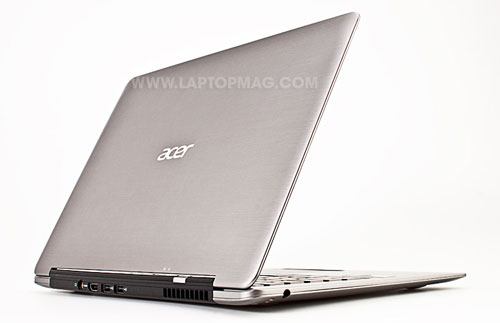
Click to enlarge
At just 0.51-0.6 inches thick, the S3 is a shade thicker than the 13-inch MacBook Air, which tapers from 0.11 to 0.68 inches. Weighing 3 pounds even, the S3 is also on a par with Apple's ultraportable. This system easily slipped into a small messenger bag and was barely noticeable as we rode home on the subway.
Heat
Heat dissipation is critical on thin systems, and thankfully the S3 does an excellent job at this. After we streamed a Hulu video at full screen for 15 minutes, the underside was a cool 85 degrees, and the touchpad and G and H keys were an even cooler 79 and 81 degrees, respectively. All are well below what we consider uncomfortable--95 degrees.
Keyboard and Touchpad
The island-style keyboard on the S3 isn't the worst we've ever used, but it was a bit stiff ; keys were large and well spaced (with the exception of the arrow keys, which were a pain), but we would have preferred a little more travel and responsiveness. On more than one occasion, the keyboard missed our inputs when we were typing at a fast pace, and we had to make a conscious effort to press harder.
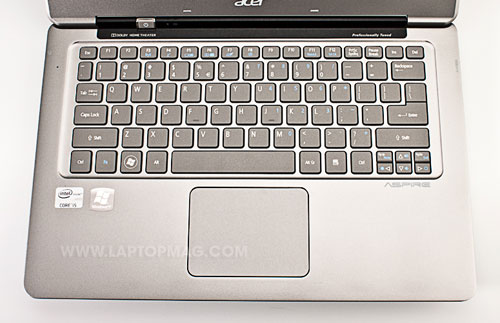
Click to enlarge
The 3.4 x 2.5-inch Elan clickpad wasn't as large as the one on the MacBook Air, but it was big and responsive enough for us to execute multitouch gestures such as pinch-to-zoom. We like that Elan added a four-finger swipe that automatically minimizes all windows to reveal the desktop. The click action on the bottom of the pad was a little mushy, though, and people who use two hands may find that it sticks.
Display and Audio
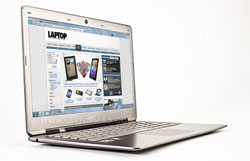
Click to enlarge
We were underwhelmed by the S3's low-quality, 13.3-inch 1366 x 768-pixel display, which offers much less screen real estate than competitors such as the ASUS UX31 (1600 x 900) and the MacBook Air 13-inch (1440 x 900). Whether watching a 480p episode of Castle on Hulu or a 720p trailer for The Avengers, we noticed plenty of pixelation and splotchiness in darker areas, and blacks weren't as true as we'd like. Viewing angles were also pretty poor. Sitting to either side of the notebook resulted in reversed images and colors, so it'll be tough sharing the screen with friends.
Two speakers, located on the underside on the left and right edges, provided adequate sound for their size, but were limited by their size. We could barely fill a cubicle when playing Notorious BIG's "Big Poppa" at full volume, and even then it was overly tinny. We liked that the Dolby Home Theater v4 utility would automatically adjust the audio settings based on what we were listening to--and indeed, added some depth and layering--but ultimately, it made little difference, as anything coming out of the speakers sounded like an AM radio.
Ports and Webcam
Though it's such a thin notebook, the S3 fits two USB 2.0 ports and a full-size HDMI port on the back, as well as an SD card reader on the right side. However, it should be noted that the ASUS UX31 has a USB 3.0 port, as well as mini HDMI and mini VGA ports.

Click to enlarge
The 1.3-megapixel webcam on the S3 returned fairly bright and crisp images. When we chatted with a friend on Google Chat, skin tones were accurate and audio remained in sync. We did notice a bit of blurring when she moved around, though.
Boot and Wake From Sleep
One of the advantages touted by Ultrabook proponents is the ability to boot and resume from sleep nearly instantly. However, that only works when the notebook has an SSD. While the Aspire S3 has a 20GB SSD, that drive is only used as a hibernation partition for saving memory to disk to enable quick resumes, not for booting or loading applications. All the action, including the bootup, occurs on the mechanical 320GB, 5,400-rpm hard drive.
Because it relies on such a slow hard drive, the Aspire S3 took 1 minute and 5 seconds to boot into Windows 7 Home Premium. That's dead on with the ultraportable category average, but far longer than the MacBook Air (17 seconds) and the Samsung Series 9 (25 seconds).
Due to the SSD hibernation partition, the S3 was able to resume from sleep in a very fast 3 seconds, which is just a second or so slower than its ultrabook competition. However, we noticed a problem where the notebook would not wake at all if we lifted the lid within just a few seconds of shutting it in the first place. In those cases, we would have to hit the power button after a few seconds to get it going.
Performance
Inside the Aspire S3 is a second-gen 1.6-GHz Intel Core i5-2467M Processor, 4GB of RAM, and a 320GB, 5,400-rpm hard drive, which powered the system to a PCMark Vantage score of 5,489. That's a good 500 points above the category average, but the MacBook Air we reviewed, which has a 1.7-GHz Core i5 processor and 128GB SSD, notched a far higher 11,230 when we ran the same test in Boot Camp. We saw similar results with Geekbench: The Aspire S3 scored 3,538, which, again, is 500 points higher than the ultraportable notebook average (3,062), but second to the MacBook Air (5,860). Still, the S3 is more than speedy enough to play movies, type in Google Docs, and listen to music.
Sadly, the mechanical hard drive wasn't the fastest in the business: It took 3 minutes and 35 seconds to duplicate a 4.97GB folder of multimedia. That's a rate of 23.7 MBps, which is far below the category average of 37 MBps.
It took the Aspire S3 8 minutes and 3 seconds to perform a VLOOKUP command in OpenOffice; that's nearly two minutes longer than the category average (6:14) as well as the MacBook Air (6:16).
Outfitted with Intel HD graphics, the S3 returned results that weren't great, but weren't unexpected either. On 3DMark06, the S3 scored 3,257, which is about 400 points above the average and 1,000 points higher than the Samsung Series 9 (2,188) but 1,000 points below the MacBook Air (4,236).
When playing World of Warcraft, the S3 averaged 26 frames per second with the display at its native resolution and effects set to Good; that's a little more than half the category average of 43 fps. When we maxed out the settings, the S3's frame rates dropped to just 11 fps, which is only 6 fps below average, but still quite unplayable. The MacBook Air managed 28 fps at these same settings.
Software
Acer keeps it clean on the Aspire S3, including little pre-loaded software. Home-grown apps include Acer Deep Sleep settings, which lets you specify whether the notebook goes into deep sleep after 120 minutes or 480 minutes; Acer Backup Manager; Acer Crystal Eye Webcam; the Acer Games portal; and Clear.fi for sharing multimedia wirelessly across a network (pictured).
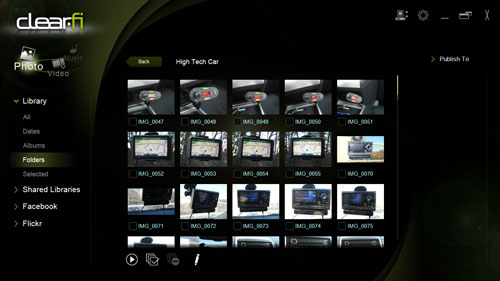
Click to enlarge
Other software includes AUPEO Internet radio, newsXpresso (a nice-looking RSS reader, pictured), Nook for PC, Skype, Microsoft Office Starter, and a 60-day trial of McAffee Internet Security.
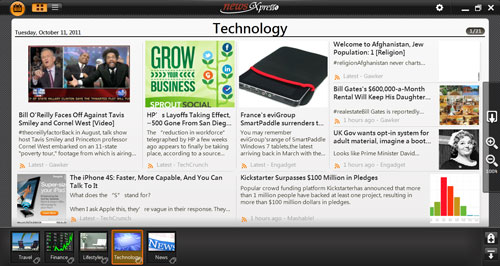
Click to enlarge
Battery Life
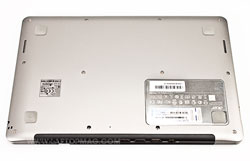
Click to enlarge
Acer claims that the Aspire S3 should get between 6 to 7 hours on a charge. Sadly, we didn't see anywhere close to that. On the LAPTOP Battery Test (web surfing via Wi-Fi), the S3 lasted just 4 hours and 23 minutes, which is two hours less than the ultraportable average and the MacBook Air (6:33). The Samsung Series 9 lasted nearly an hour longer, too: 5:11. We will retest the S3 and update this review if necessary.
Update: A second battery test yielded similar results: 4 hours and 25 minutes.
Configurations
Currently, Acer does not offer any other configurations of the Aspire S3.
Verdict
Priced at $899, it's clear that Acer is trying to undercut its Ultrabook competitors, but in doing so, it had to make a few sacrifices. For example, the Aspire S3's chassis is plastic, not metal, and it has a mechanical hard drive, not an SSD. It's also missing the little niceties, such as a high-res display and a backlit keyboard. While we might be willing to compromise on those issues, the one area where we can't compromise is battery life, and unfortunately the S3 falls way short in that category. The less-sexy ASUS U36SD is also less than an inch thick, and it offers much better performance and 8 hours of battery life for around the same price as the S3. Or, for just $200 more, you can get ASUS' Zenbook UX31, which has a higher-res screen and a powerful 256GB SSD.
Acer Aspire S3 Specs
| Bluetooth | Bluetooth 4.0 |
| Brand | Acer |
| CPU | 1.6-GHz Intel Core i5-2467M |
| Card Slots | 2-1 card reader |
| Company Website | http://www.acer.com |
| Display Size | 13.3 |
| Graphics Card | Intel HD |
| Hard Drive Size | 20GB SSD and 320GB HDD |
| Hard Drive Speed | 5,400rpm |
| Hard Drive Type | Multiple Drives |
| Native Resolution | 1366x768 |
| Operating System | MS Windows 7 Home Premium (64-bit) |
| Optical Drive | None |
| Optical Drive Speed | n/a |
| Ports (excluding USB) | Headphone, HDMI |
| RAM | 4GB |
| RAM Upgradable to | 4GB |
| Size | 12.6 x 8.5 x 0.5-0.6 inches |
| Touchpad Size | 3.4 x 2.5 inches |
| USB Ports | 2 |
| Weight | 3 pounds |
| Wi-Fi | 802.11b/g/n |
Michael was the Reviews Editor at Laptop Mag. During his tenure at Laptop Mag, Michael reviewed some of the best laptops at the time, including notebooks from brands like Acer, Apple, Dell, Lenovo, and Asus. He wrote in-depth, hands-on guides about laptops that defined the world of tech, but he also stepped outside of the laptop world to talk about phones and wearables. He is now the U.S. Editor-in-Chief at our sister site Tom's Guide, where he oversees all evergreen content and the Homes, Smart Home, and Fitness/Wearables categories for the site..
